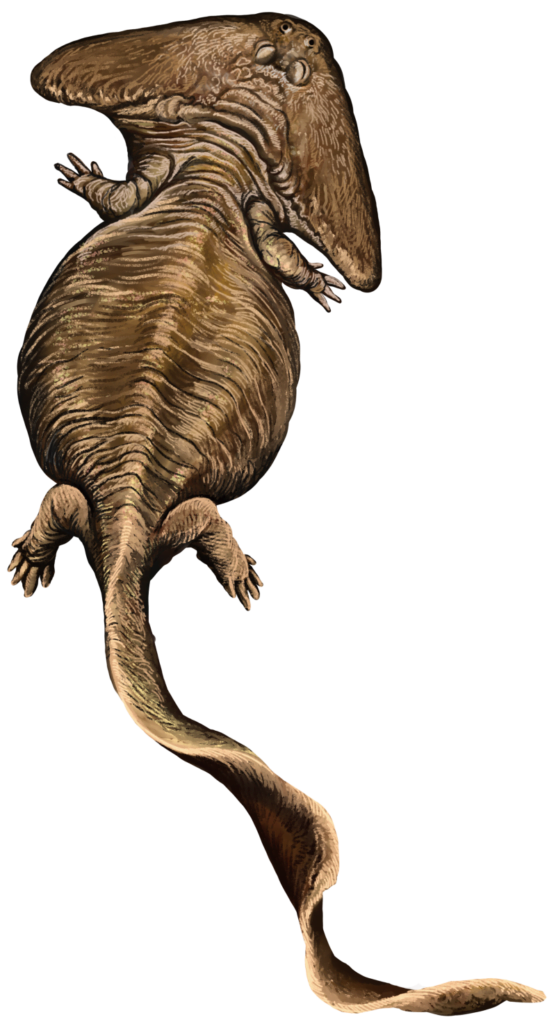Diplocaulus: Master of the Primeval Swamp
Meet the boomerang-headed amphibian that slices through water like a living stealth submarine!
Diplocaulus is a sleek, amphibious predator with a distinctive boomerang-shaped skull that flares into wide, lateral extensions. Its body measures about a meter in length, covered in smooth, mottled skin that blends with murky water. Its large eyes sit atop its head, giving it a wide field of vision, while its powerful, flattened tail propels it through aquatic environments with precision. The limbs are short but muscular, aiding in maneuvering along soft-bottomed wetlands.
Behavior:
Diplocaulus spends most of its time submerged, lurking near the bottom in dense vegetation or muddy shallows. It remains motionless for long periods, ambushing passing prey with explosive lunges. It is solitary, silent, and calculating, avoiding confrontation through stealth and speed. It surfaces rarely, breathing air when needed, but quickly returns to the cover of water where it is most at home.
Habitat:
Diplocaulus inhabits slow-moving rivers, swamps, and floodplain wetlands of the Permian world. It prefers areas with thick plant cover, soft sediment, and abundant prey. The environment teems with danger, and Diplocaulus thrives by mastering its watery terrain.
Modus Operandi:
As an ambush predator, Diplocaulus uses stillness and camouflage to remain undetected. When prey—a fish, insect, or crustacean—comes within range, it opens its wide mouth and uses suction to drag it in. Its unique skull shape channels water smoothly around its body, reducing drag and aiding quick turns. Against predators, the massive head flanges act as a deterrent, making it hard to swallow and possibly allowing sudden, gliding escapes through the water.
Motivation:
Diplocaulus is driven by survival through specialization. Every feature, from its hydrofoil skull to its low-slung stance, serves a clear purpose: dominate its niche, avoid becoming prey, and feed efficiently in a competitive ecosystem. It does not adapt—it is already perfectly adapted.
Diplocaulus 5e
Diplocaulus 3.5
Diplocaulus
Small Beast, Unaligned
Armor Class 14 (natural armor)
Hit Points 52 (8d6 + 24)
Speed 30 ft., swim 40 ft.
In still swamps forgotten by time, a strange, boomerang-headed shape glides just beneath the surface, waiting for its chance to strike with silent precision.
| STR | DEX | CON | INT | WIS | CHA |
|---|---|---|---|---|---|
| 12 (+1) | 16 (+3) | 16 (+3) | 2 (–4) | 12 (+1) | 6 (–2) |
Saving Throws
Dex +5, Wis +3
Skills Stealth +5, Perception +3
Senses darkvision 60 ft., passive Perception 13
Languages —
Challenge 2 (450 XP) Proficiency Bonus +2
Amphibious Nature.
The Diplocaulus can breathe both air and water.
Skull-Hydrofoil.
Its wide, curved head acts like a built-in stabilizer. While swimming, it has advantage on Dexterity saving throws, and opportunity attacks against it in water are made with disadvantage.
Ambush Predator.
If the Diplocaulus surprises a creature and hits it with an attack on its first turn in combat, the target takes an extra 7 (2d6) damage.
Swamp Camouflage.
The Diplocaulus has advantage on Dexterity (Stealth) checks made to hide in swamps, marshes, or underwater vegetation.
Actions
Bite. Melee Weapon Attack:
+3 to hit, reach 5 ft., one target.
Hit: 8 (2d6 + 1) piercing damage.
Suction Snap (Recharge 5–6).
The Diplocaulus rapidly expands its mouth, creating a burst of suction. Each creature in a 15-foot cone must make a DC 13 Strength saving throw. On a failed save, a creature is pulled 10 feet closer and takes 10 (3d6) bludgeoning damage. On a successful save, the creature takes half damage and is not moved.
Creatures that are Huge or larger are unaffected.
Reactions
Horn Deflection.
When a melee attack is made against the Diplocaulus by a creature it can see while in water, it can use its reaction to twist its skull and impose disadvantage on the attack roll.
Tactics
- Opening Strategy: Uses Swamp Camouflage to stay hidden, then begins combat with Suction Snap to isolate and disorient prey.
- Mobility: Slips between reeds and debris with ease, using superior swimming and tight turns to avoid melee entanglements.
- Targeting: Focuses on separated or lightly armored creatures, avoiding large groups or heavily armored foes.
- Retreat: If severely injured, it uses its superior swimming speed and Skull-Hydrofoil to escape into deeper water or thick cover.
Optional Variant: Diplocaulus Alpha (CR 3 — Medium Beast)
A rare, mature specimen—older, stronger, and nearly 6 feet long.
- Size: Medium
- HP: 75 (10d8 + 30)
- Suction Snap cone increases to 30 feet
- Gains Multiattack (2 Bites)
- Legendary Resistance (1/day)

– https://doi.org/10.7875/togopic.2020.208,
CC BY 4.0, https://commons.wikimedia.
org/w/index.php?curid=97833533
Originally Posted by Shade of the En World forums.
This three-foot-long amphibian has a pancack-shaped body and a large, boomerang-shaped head. Its legs are short, and its tail is long and flat. A diplocaulus is a prehistoric amphibian with an odd-shaped head. This oversized head makes it difficult to swallow by the many larger predators in its environment. A diplocaulus spends most of its time on the bottom of rivers and streams, waiting for small fish and insects on which to prey. A diplocaulus is about 3 feet long.
Diplocaulus is known for the long protrusions on the sides of its skull, which cause the skull to be shaped similar to a boomerang. Judging from its weak limbs and relatively short tail, it is presumed to have swum with an up-and-down movement of its body, not unlike cetaceans today. The wide head could have helped the creature glide through the water. Also, it is thought to have had defensive purposes as any predator (even the large-headed Eryops) would have a hard time trying to swallow a creature with such a wide head.
| Diplocaulus | |
| Small animal (Aquatic) | |
| Hit Dice | 1d8+1 (5 hp) |
| Initiative | +2 |
| Speed | 5 ft. (1 square), Swim 40 ft. |
| Armor Class | 14 (+2 size, +2 Dexterity), touch 14, flat-footed 12 |
| Base Attack/Grapple | +0/-9 |
| Attack | Bite +4 melee (1d4-1) |
| Full Attack | Bite +4 melee (1d4-1) |
| Space/Reach | 2-1/2 ft./0 ft. |
| Special Attacks | – |
| Special Qualities | Amphibious, hard to swallow, hydrofoil, Low-Light Vision |
| Saves | Fort +3, Ref +2, Will +0 |
| Abilities | Strength 9, Dexterity 14, Constitution 13, Intelligence 1, Wisdom 11, Charisma 5 |
| Skills | Hide +12, Listen +3, Move Silently +7, Spot +3, Swim +8 |
| Feats | Alertness, Weapon Finesse (B) |
| Environment | Warm aquatic |
| Organization | Solitary |
| Challenge Rating | 1/2 |
| Treasure | None |
| Alignment | Always neutral |
| Advancement | 2 HD (Tiny), 3-4 HD (Small) |
| Level Adjustment | – |
COMBAT
A diplocaulus generally attempts to escape if threatened by a larger creature.
Hard to Swallow (Ex): A diplocaulus counts as one size category larger for the purposes of being swallowed whole.
Hydrofoil (Ex): A diplocaulus gains a +4 bonus on any Swim check made to Swim against a current.
Skills: A diplocaulus has a +4 racial bonus on all Hide and Move Silently checks. A diplocaulus has a +8 racial bonus on any Swim checks to perform some special action or avoid a hazard. It can always take 10 on Swim checks even if distracted or endangered. It can use the run action while swimming, provided it swims in a straight line.
Originally appeared in Dragon Magazine #112 (1986) as “Labrynthodont”.

 Buy me a coffee
Buy me a coffee